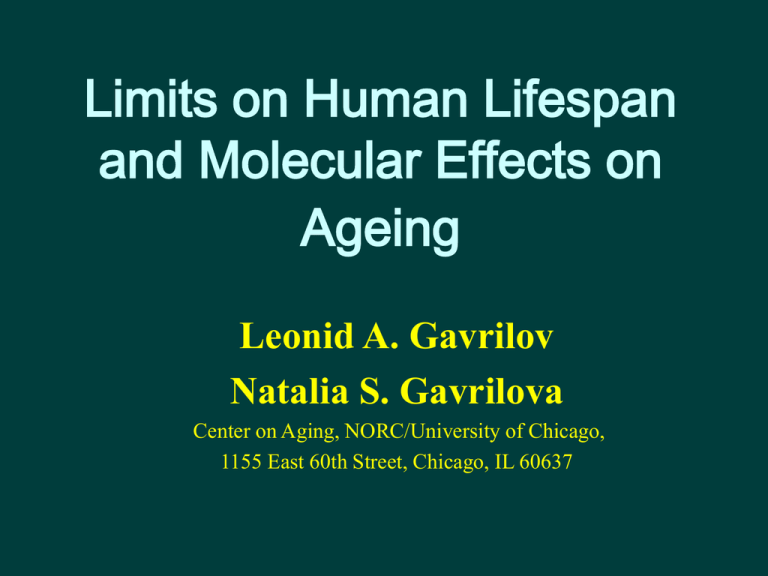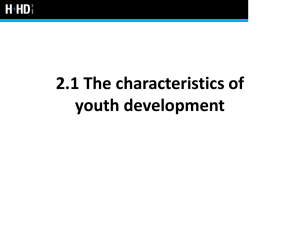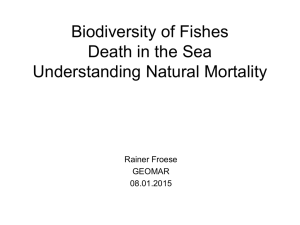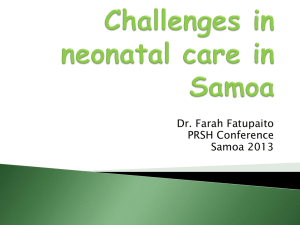
Limits on Human Lifespan
and Molecular Effects on
Ageing
Leonid A. Gavrilov
Natalia S. Gavrilova
Center on Aging, NORC/University of Chicago,
1155 East 60th Street, Chicago, IL 60637
Questions of Scientific and
Practical (Actuarial) Significance
• How far could mortality decline go?
(absolute zero seems implausible)
• Are there any ‘biological’ limits to human mortality
decline, determined by ‘reliability’ of human body?
(lower limits of mortality dependent on age, sex, and
population genetics)
• Were there any indications for ‘biological’ mortality
limits in the past?
• Are there any indications for mortality limits now?
The Gompertz-Makeham Law
μ(x) = A + R0exp(α x)
A – Makeham term or background
mortality
R0exp(α x) – age-dependent mortality
Historical Changes in Mortality
for 40-year-old Swedish Males
1. Total mortality
2. Background
mortality
3. Age-dependent
mortality
•
Source: Gavrilov,
Gavrilova, “The
Biology of Life Span”
1991
Historical Changes in Mortality for
40-year-old Women in Norway and
Denmark
1.
2.
3.
4.
Norway, total mortality
Denmark, total
mortality
Norway, age-dependent
mortality
Denmark, agedependent mortality
Source: Gavrilov, Gavrilova,
“The Biology of Life Span”
1991
Historical Changes in Mortality for
40-year-old Italian Women and Men
1.
2.
3.
4.
Women, total
mortality
Men, total mortality
Women, agedependent mortality
Men, age-dependent
mortality
Source: Gavrilov, Gavrilova,
“The Biology of Life
Span” 1991
Historical Changes in Mortality
Swedish Females
1
1925
1960
1980
1999
Log (Hazard Rate)
0.1
0.01
0.001
0.0001
0
20
40
60
Age
80
100
Historical Changes in Survival
from Age 90 to 100 years. France
Percent Surviving from Age 90 to 100
6
5
Females
Males
4
3
2
1
0
1900
1920
1940
1960
Calendar Year
1980
2000
Historical Changes in Survival
from Age 90 to 100 years. Japan
Percent Surviving from Age 90 to 100
10
Females
Males
8
6
4
2
0
1950
1960
1970
1980
Calendar Year
1990
2000
Extension of the GompertzMakeham Model through the
Factor Analysis of Mortality Trends
Mortality force (age, time) =
= a0(age) + a1(age) x F1(time) + a2(age) x F2(time)
Factor Analysis of Mortality
Swedish Females
4
Factor 1 ('young ages')
Factor 2 ('old ages')
3
Factor score
2
1
0
-1
-2
1900
1920
1940
Year
1960
1980
2000
Preliminary Conclusions
• There was some evidence for ‘ biological’
mortality limits in the past, but these ‘limits’
proved to be responsive to the recent technological
and medical progress.
• Thus, there is no convincing evidence for absolute
‘biological’ mortality limits now.
• Analogy for illustration and clarification: There was a limit to
the speed of airplane flight in the past (‘sound’ barrier), but it was
overcome by further technological progress. Similar observations
seems to be applicable to current human mortality decline.
Molecular Effects on Ageing
New Ideas and Findings by Bruce Ames:
• The rate of mutation damage is NOT immutable, but it can be
dramatically decreased by very simple measures:
-- Through elimination of deficiencies in vitamins and other
micronutrients (iron, zinc, magnesium, etc).
• Micronutrient deficiencies are very common even in the modern
wealthy populations
• These deficiencies are much more important than radiation, industrial
pollution and most other hazards
Our hypothesis:
Remarkable improvement in the oldest-old survival may reflect an unintended
retardation of the aging process, caused by decreased damage accumulation,
because of improving the micronutrient status in recent decades
Micronutrient Undernutrition in Americans
Nutrient
% ingesting
Population Group
RDA
< RDA
% ingesting
<<50%
50% RDA
RDA
Minerals
Iron
Women 20-30 years
18 mg
75%
25%
Women 50+ years
8 mg
25%
5-10%
Men; Women 50+ years
11; 8 mg
50%
10%
B6
Men; Women
1.7; 1.5 mg
50%
10%
Folate**
Men; Women
400 mcg
75%
25%; 50%
B12
Men; Women
2.4 mcg
10-20; 25-50 %
5; ~10-25%
C
Men; Women
90; 75 mg
50%
25%
Zinc
Vitamins
•Wakimoto and Block (2001) J Gerontol A Biol Sci Med Sci. Oct; 56 Spec No 2(2):65-80.
** Before U.S. Food Fortification
Source: Presentation by Bruce Ames at the IABG Congress
Molecular Effects on Ageing (2)
Ideas and Findings by Bruce Ames:
• The rate of damage accumulation is NOT immutable, but it can be
dramatically decreased by PREVENTING INFLAMMATION:
Inflammation causes tissue damage through many mechanisms
including production of Hypochlorous acid (HOCl), which produces
DNA damage (through incorporation of chlorinated nucleosides).
Chronic inflammation may contribute to many age-related degenerative
diseases including cancer
Hypothesis:
Remarkable improvement in the oldest-old survival may reflect an unintended
retardation of the aging process, caused by decreased damage accumulation,
because of partial PREVENTION of INFLAMMATION through better control
over infectious diseases in recent decades
Characteristic of our Dataset
• Over 16,000 persons
belonging to the European
aristocracy
• 1800-1880 extinct birth
cohorts
• Adult persons aged 30+
• Data extracted from the
professional genealogical
data sources including
Genealogisches Handbook
des Adels, Almanac de
Gotha, Burke Peerage and
Baronetage.
Season of Birth and Female Lifespan
8,284 females from European aristocratic families
born in 1800-1880
Seasonal Differences in Adult Lifespan at Age 30
3
•
Life expectancy of adult
women (30+) as a function of
month of birth (expressed as
a difference from the
reference level for those
born in February).
•
The data are point estimates
(with standard errors) of the
differential intercept
coefficients adjusted for
other explanatory variables
using multivariate
regression with categorized
nominal variables.
p=0.006
Lifespan Difference (yr)
p=0.02
2
1
0
FEB MAR APR MAY JUN JUL AUG SEP OCT NOV DEC JAN FEB.
Month of Birth
Season of Birth and Female Lifespan
6,517 females from European aristocratic families
born in 1800-1880
Seasonal Differences in Adult Lifespan at Age 60
2
•
Life expectancy of adult
women (60+) as a function of
month of birth (expressed as
a difference from the
reference level for those
born in February).
•
The data are point estimates
(with standard errors) of the
differential intercept
coefficients adjusted for
other explanatory variables
using multivariate
regression with categorized
nominal variables.
Lifespan Difference (yr)
p=0.008
p=0.04
1
0
FEB MAR APR MAY JUN JUL AUG SEP OCT NOV DEC JAN FEB.
Month of Birth
Mean Lifespan of Females
Born in December and February
as a Function of Birth Year
Mean Lifespan, years
80
75
70
65
60
Born in February
Born in December
Linear Regression Fit
1800
1820
1840
1860
Year of Birth
1880
• Life
expectancy of
adult women
(30+) as a
function of
year of birth
Daughters' Lifespan (30+) as a Function
of Paternal Age at Daughter's Birth
6,032 daughters from European aristocratic families
born in 1800-1880
1
•
Life expectancy of adult women
(30+) as a function of father's
age when these women were
born (expressed as a difference
from the reference level for
those born to fathers of 40-44
years).
•
The data are point estimates
(with standard errors) of the
differential intercept coefficients
adjusted for other explanatory
variables using multiple
regression with nominal
variables.
•
Daughters of parents who
survived to 50 years.
Lifespan Difference (yr)
0
-1
-2
-3
p = 0.04
-4
15-24 25-29 30-34 35-39 40-44 45-49 50-54 55-59
Paternal Age at Reproduction
Daughters' Lifespan (60+) as a Function
of Paternal Age at Daughter's Birth
4,832 daughters from European aristocratic families
born in 1800-1880
1
•
Life expectancy of older
women (60+) as a function of
father's age when these women
were born (expressed as a
difference from the reference
level for those born to fathers of
40-44 years).
•
The data are point estimates
(with standard errors) of the
differential intercept coefficients
adjusted for other explanatory
variables using multiple
regression with nominal
variables.
•
Daughters of parents who
survived to 50 years.
Lifespan Difference (yr)
0
-1
-2
p = 0.004
-3
15-24 25-29 30-34 35-39 40-44 45-49 50-54 55-59
Paternal Age at Reproduction
Paternal Age as a Risk Factor
for Alzheimer Disease
Parental age at childbirth (years)
40
• MGAD - major
gene for Alzheimer
Disease
p = 0.04
35
NS
p=0.04
NS
NS
30
NS
25
Paternal age
Maternal age
Sporadic Alzheimer Disease (low likelihood of MGAD)
Familial Alzheimer Disease (high likelihood of MGAD)
Controls
• Source: L. Bertram
et al.
Neurogenetics,
1998, 1: 277-280.
Paternal Age and Risk
of Schizophrenia
•
Estimated cumulative
incidence and
percentage of offspring
estimated to have an
onset of schizophrenia
by age 34 years, for
categories of paternal
age. The numbers
above the bars show
the proportion of
offspring who were
estimated to have an
onset of schizophrenia
by 34 years of age.
•
Source: Malaspina et al.,
Arch Gen
Psychiatry.2001.
Aging is a Very General Phenomenon!
What Should
the Aging Theory Explain:
• Why do most biological species deteriorate with age?
• Specifically, why do mortality rates increase exponentially
with age in many adult species (Gompertz law)?
• Why does the age-related increase in mortality rates vanish
at older ages (mortality deceleration)?
• How do we explain the so-called compensation law of
mortality (Gavrilov & Gavrilova, 1991)?
Exponential Increase of Death Rate
with Age in Fruit Flies
(Gompertz Law of Mortality)
Linear dependence of
the logarithm of
mortality force on the
age of Drosophila.
Based on the life table
for 2400 females of
Drosophila melanogaster
published by Hall (1969).
Mortality force was
calculated for 3-day age
intervals.
Source: Gavrilov, Gavrilova,
“The Biology of Life Span” 1991
Age-Trajectory of Mortality in Flour Beetles
(Gompertz-Makeham Law of Mortality)
Dependence of the
logarithm of mortality force
(1) and logarithm of
increment of mortality force
(2) on the age of flour
beetles (Tribolium confusum
Duval).
Based on the life table
for 400 female flour beetles
published by Pearl and
Miner (1941). Mortality
force was calculated for 30day age intervals.
Source: Gavrilov, Gavrilova,
“The Biology of Life Span”
1991
Age-Trajectory of Mortality in Italian Women
(Gompertz-Makeham Law of Mortality)
Dependence of the
logarithm of mortality
force (1) and logarithm of
increment of mortality
force (2) on the age of
Italian women.
Based on the official
Italian period life table for
1964-1967. Mortality force
was calculated for 1-year
age intervals.
Source: Gavrilov, Gavrilova,
“The Biology of Life Span”
1991
Compensation Law of Mortality
Convergence of Mortality Rates with Age
1 – India, 1941-1950, males
2 – Turkey, 1950-1951, males
3 – Kenya, 1969, males
4 - Northern Ireland, 1950-1952,
males
5 - England and Wales, 19301932, females
6 - Austria, 1959-1961, females
7 - Norway, 1956-1960, females
Source: Gavrilov, Gavrilova,
“The Biology of Life Span” 1991
Compensation Law of Mortality
in Laboratory Drosophila
1 – drosophila of the Old Falmouth,
New Falmouth, Sepia and Eagle
Point strains (1,000 virgin
females)
2 – drosophila of the Canton-S strain
(1,200 males)
3 – drosophila of the Canton-S strain
(1,200 females)
4 - drosophila of the Canton-S strain
(2,400 virgin females)
Mortality force was calculated for 6day age intervals.
Source: Gavrilov, Gavrilova,
“The Biology of Life Span” 1991
Mortality at Advanced Ages
Source: Gavrilov L.A., Gavrilova N.S. The Biology of Life Span:
A Quantitative Approach, NY: Harwood Academic Publisher, 1991
M. Greenwood, J. O. Irwin. BIOSTATISTICS OF SENILITY
Survival Patterns After Age 90
Percent surviving (in log scale) is
plotted as a function of age of Swedish
women for calendar years 1900, 1980,
and 1999 (cross-sectional data). Note
that after age 100, the logarithm of
survival fraction is decreasing without
much further acceleration (aging) in
almost a linear fashion. Also note an
increasing pace of survival improvement
in history: it took less than 20 years
(from year 1980 to year 1999) to repeat
essentially the same survival
improvement that initially took 80 years
(from year 1900 to year 1980).
Source: cross-sectional (period) life
tables at the Berkeley Mortality
Database (BMD):
http://www.demog.berkeley.edu/~bmd/
Non-Gompertzian Mortality Kinetics
of Four Invertebrate Species
Non-Gompertzian mortality
kinetics of four invertebrate
species: nematodes,
Campanularia flexuosa,
rotifers and shrimp.
Source: A. Economos.
A non-Gompertzian
paradigm for mortality
kinetics of metazoan
animals and failure kinetics
of manufactured products.
AGE, 1979, 2: 74-76.
Non-Gompertzian Mortality Kinetics
of Three Rodent Species
Non-Gompertzian
mortality kinetics of
three rodent species:
guinea pigs, rats and
mice.
Source: A. Economos.
A non-Gompertzian
paradigm for mortality
kinetics of metazoan
animals and failure
kinetics of manufactured
products. AGE, 1979, 2:
74-76.
Non-Gompertzian Mortality Kinetics
of Three Industrial Materials
Non-Gompertzian
mortality kinetics of three
industrial materials: steel,
industrial relays and
motor heat insulators.
Source: A. Economos.
A non-Gompertzian
paradigm for mortality
kinetics of metazoan
animals and failure
kinetics of manufactured
products. AGE, 1979, 2:
74-76.
Redundancy Creates Both Damage Tolerance
and Damage Accumulation (Aging)
Damage
Defect
No redundancy
Death
Damage
Defect
Redundancy
Damage accumulation
(aging)
Differences in reliability structure between
(a) technical devices and (b) biological systems
Statement of the HIDL hypothesis:
(Idea of High Initial Damage Load )
"Adult organisms already have an
exceptionally high load of initial damage,
which is comparable with the amount of
subsequent aging-related deterioration,
accumulated during the rest of the entire
adult life."
Source: Gavrilov, L.A. & Gavrilova, N.S. 1991. The Biology of Life Span:
A Quantitative Approach. Harwood Academic Publisher, New York.
Why should we expect high initial
damage load ?
• General argument:
-- In contrast to technical devices, which are built from pretested high-quality components, biological systems are formed by
self-assembly without helpful external quality control.
• Specific arguments:
1. Cell cycle checkpoints are disabled in early
development (Handyside, Delhanty,1997. Trends
Genet. 13, 270-275 )
2. extensive copy-errors in DNA, because most cell
divisions responsible for DNA copy-errors occur in
early-life (loss of telomeres is also particularly high in
early-life)
3. ischemia-reperfusion injury and asphyxia-reventilation
injury during traumatic process of 'normal' birth
Spontaneous mutant frequencies with
age in heart and small intestine
Small Intestine
Heart
35
-5
Mutant frequency (x10 )
40
30
25
20
15
10
5
0
0
5
10
15
20
Age (months)
25
30
35
Source: Presentation of Jan Vijg at the IABG Congress, Cambridge, 2003
Birth Process is a Potential
Source of High Initial Damage
•
During birth, the future child is deprived
of oxygen by compression of the
umbilical cord and suffers severe
hypoxia and asphyxia. Then, just after
birth, a newborn child is exposed to
oxidative stress because of acute
reoxygenation while starting to breathe.
It is known that acute reoxygenation
after hypoxia may produce extensive
oxidative damage through the same
mechanisms that produce ischemiareperfusion injury and the related
phenomenon, asphyxia-reventilation
injury. Asphyxia is a common
occurrence in the perinatal period, and
asphyxial brain injury is the most
common neurologic abnormality in the
neonatal period that may manifest in
neurologic disorders in later life.
Practical implications from
the HIDL hypothesis:
"Even a small progress in optimizing the early-developmental
processes can potentially result in a remarkable prevention of
many diseases in later life, postponement of aging-related
morbidity and mortality, and significant extension of healthy
lifespan."
"Thus, the idea of early-life programming of aging and longevity
may have important practical implications for developing earlylife interventions promoting health and longevity."
Source: Gavrilov, L.A. & Gavrilova, N.S. 1991. The Biology of Life Span:
A Quantitative Approach. Harwood Academic Publisher, New York.
Failure Kinetics in Mixtures of Systems with
Different Redundancy Levels
Initial Period
The dependence of
logarithm of
mortality force
(failure rate) as a
function of age in
mixtures of parallel
redundant systems
having Poisson
distribution by
initial numbers of
functional elements
(mean number of
elements, = 1, 5,
10, 15, and 20.
Daughter's Lifespan
(Mean Deviation from Cohort Life Expectancy)
Daughter's Lifespan (deviation), years
as a Function of Paternal Lifespan
6
4
2
0
-2
40
50
60
70
80
90
Paternal Lifespan, years
100
• Offspring data
for adult lifespan
(30+ years) are
smoothed by
5-year running
average.
• Extinct birth
cohorts (born in
1800-1880)
• European
aristocratic
families.
6,443 cases
Offspring Lifespan at Age 30
as a Function of Paternal Lifespan
Data are adjusted for other predictor variables
4
2
p=0.006
p=0.05
0
p=0.001
4
Lifespan difference, years
Lifespan difference, years
p=0.0003
p<0.0001
p=0.001
2
0
-2
-2
40
50
60
70
80
90
Paternal Lifespan, years
Daughters, 8,284 cases
100
40
50
60
70
80
90
Paternal Lifespan, years
Sons, 8,322 cases
100
Offspring Lifespan at Age 60
as a Function of Paternal Lifespan
Data are adjusted for other predictor variables
4
p=0.0001
2
p=0.04
p=0.04
0
Lifespan difference, years
Lifespan difference, years
4
p=0.0003
2
p=0.004
p=0.006
0
-2
-2
40
50
60
70
80
90
Paternal Lifespan, years
Daughters, 6,517 cases
100
40
50
60
70
80
90
Paternal Lifespan, years
Sons, 5,419 cases
100
Offspring Lifespan at Age 30
as a Function of Maternal Lifespan
Data are adjusted for other predictor variables
4
p=0.0004
p=0.02
Lifespan difference, years
Lifespan difference, years
4
2
p=0.01
p=0.05
0
2
0
-2
-2
40
50
60
70
80
90
100
Maternal Lifespan, years
Daughters, 8,284 cases
40
50
60
70
80
90
Maternal Lifespan, years
Sons, 8,322 cases
100
Offspring Lifespan at Age 60
as a Function of Maternal Lifespan
Data are adjusted for other predictor variables
4
Lifespan difference, years
Lifespan difference, years
p<0.0001
4
2
p=0.01
p=0.01
0
p=0.04
2
0
-2
-2
40
50
60
70
80
90
100
Maternal Lifespan, years
Daughters, 6,517 cases
40
50
60
70
80
90
Maternal Lifespan, years
Sons, 5,419 cases
100
Person’s Lifespan as a Function
of Spouse Lifespan
Data are adjusted for other predictor variables
6
Lifespan difference, years
Lifespan difference, years
6
4
2
0
4
2
0
-2
-2
40
50
60
70
80
90
100
Spouse Lifespan, years
Married Women, 6,442 cases
-4
40
50
60
70
80
90
100
Spouse Lifespan, years
Married Men, 6,596 cases
Conclusions (I)
•
Redundancy is a key notion for understanding
aging and the systemic nature of aging in
particular. Systems, which are redundant in
numbers of irreplaceable elements, do deteriorate
(i.e., age) over time, even if they are built of nonaging elements.
•
An actuarial aging rate or expression of aging
(measured as age differences in failure rates,
including death rates) is higher for systems with
higher redundancy levels.
Conclusions (II)
•
Redundancy exhaustion over the life course explains the
observed ‘compensation law of mortality’ (mortality
convergence at later life) as well as the observed late-life
mortality deceleration, leveling-off, and mortality plateaus.
•
Living organisms seem to be formed with a high load of
initial damage, and therefore their lifespans and aging
patterns may be sensitive to early-life conditions that
determine this initial damage load during early
development. The idea of early-life programming of aging
and longevity may have important practical implications
for developing early-life interventions promoting health
and longevity.
Acknowledgments
This study was made possible thanks to:
• generous support from the National
Institute on Aging, and
• stimulating working environment at the
Center on Aging, NORC/University of
Chicago








